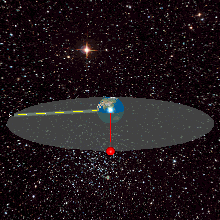geosynchronous satellites on:
[Wikipedia]
[Google]
[Amazon]
 A geosynchronous satellite is a satellite in
A geosynchronous satellite is a satellite in
 Geostationary satellites appear to be fixed over one spot above the equator. Receiving and transmitting
Geostationary satellites appear to be fixed over one spot above the equator. Receiving and transmitting
Lyngsat list of communications satellites in geostationary orbit
*For an interactive list of active inactive satellites geosynchronous and orbital a
NORAD Celestrack
{{DEFAULTSORT:Geosynchronous Satellite Satellites by orbit Satellite broadcasting Telecommunications-related introductions in 1963
 A geosynchronous satellite is a satellite in
A geosynchronous satellite is a satellite in geosynchronous orbit
A geosynchronous orbit (sometimes abbreviated GSO) is an Earth-centered orbit with an orbital period that matches Earth's rotation on its axis, 23 hours, 56 minutes, and 4 seconds (one sidereal day). The synchronization of rotation and orbital ...
, with an orbital period the same as the Earth's rotation period. Such a satellite returns to the same position in the sky after each sidereal day, and over the course of a day traces out a path in the sky that is typically some form of analemma. A special case of geosynchronous satellite is the geostationary satellite, which has a geostationary orbit
A geostationary orbit, also referred to as a geosynchronous equatorial orbit''Geostationary orbit'' and ''Geosynchronous (equatorial) orbit'' are used somewhat interchangeably in sources. (GEO), is a circular geosynchronous orbit in altitud ...
– a circular geosynchronous orbit directly above the Earth's equator
The equator is a circle of latitude, about in circumference, that divides Earth into the Northern and Southern hemispheres. It is an imaginary line located at 0 degrees latitude, halfway between the North and South poles. The term can als ...
. Another type of geosynchronous orbit used by satellites is the Tundra elliptical orbit.
Geostationary satellites have the unique property of remaining permanently fixed in exactly the same position in the sky as viewed from any fixed location on Earth, meaning that ground-based antennas do not need to track them but can remain fixed in one direction. Such satellites are often used for communication purposes; a geosynchronous network is a communication network based on communication with or through geosynchronous satellites.
Definition
The term ''geosynchronous'' refers to the satellite's orbital period which enables it to be with the rotation of the Earth ("geo-"). Along with this orbital period requirement, to be ''geostationary
A geostationary orbit, also referred to as a geosynchronous equatorial orbit''Geostationary orbit'' and ''Geosynchronous (equatorial) orbit'' are used somewhat interchangeably in sources. (GEO), is a circular geosynchronous orbit in altitude ...
'' as well, the satellite must be placed in an orbit that puts it in the vicinity over the equator. These two requirements make the satellite appear in an unchanging area of visibility when viewed from the Earth's surface, enabling continuous operation from one point on the ground. The special case of a geostationary orbit is the most common type of orbit for communications satellites.
If a geosynchronous satellite's orbit is not exactly aligned with the Earth's equator
The equator is a circle of latitude, about in circumference, that divides Earth into the Northern and Southern hemispheres. It is an imaginary line located at 0 degrees latitude, halfway between the North and South poles. The term can als ...
, the orbit is known as an inclined orbit. It will appear (when viewed by someone on the ground) to oscillate daily around a fixed point. As the angle between the orbit and the equator decreases, the magnitude of this oscillation becomes smaller; when the orbit lies entirely over the equator in a circular orbit, the satellite remains stationary relative to the Earth's surface – it is said to be ''geostationary''.
Application
, there are approximately 446 active geosynchronous satellites, some of which are not operational. Geostationary satellites appear to be fixed over one spot above the equator. Receiving and transmitting
Geostationary satellites appear to be fixed over one spot above the equator. Receiving and transmitting antenna
Antenna ( antennas or antennae) may refer to:
Science and engineering
* Antenna (radio), also known as an aerial, a transducer designed to transmit or receive electromagnetic (e.g., TV or radio) waves
* Antennae Galaxies, the name of two collid ...
s on the earth do not need to track such a satellite. These antennas can be fixed in place and are much less expensive than tracking antennas. These satellites have revolutionized global communications, television broadcasting and weather forecasting, and have a number of important defense
Defense or defence may refer to:
Tactical, martial, and political acts or groups
* Defense (military), forces primarily intended for warfare
* Civil defense, the organizing of civilians to deal with emergencies or enemy attacks
* Defense industr ...
and intelligence applications.
One disadvantage of geostationary satellites is a result of their high altitude: radio signals take approximately 0.25 of a second to reach and return from the satellite, resulting in a small but significant signal delay
Delay (from Latin: dilatio) may refer to:
Arts, entertainment, and media
* ''Delay 1968'', a 1981 album by German experimental rock band Can
* ''The Delay'', a 2012 Uruguayan film
People
* B. H. DeLay (1891–1923), American aviator and acto ...
. This delay increases the difficulty of telephone conversation and reduces the performance of common network protocols such as TCP/IP, but does not present a problem with non-interactive systems such as satellite television broadcasts. There are a number of proprietary satellite data protocols that are designed to proxy TCP/IP connections over long-delay satellite links—these are marketed as being a partial solution to the poor performance of native TCP over satellite links. TCP presumes that all loss is due to congestion, not errors, and probes link capacity with its " slow start" algorithm, which only sends packets once it is known that earlier packets have been received. Slow start is very slow over a path using a geostationary satellite. RFC 2488, written in 1999, gives several suggestions on this issue.
There are some advantages of geo-stationary satellites:
*Get high temporal resolution data.
*Tracking of the satellite by its earth stations is simplified.
*Satellite always in same position.
A disadvantage of geostationary satellites is the incomplete geographical coverage, since ground stations at higher than roughly 60 degrees latitude have difficulty reliably receiving signals at low elevations. Satellite dish
A satellite dish is a dish-shaped type of parabolic antenna designed to receive or transmit information by radio waves to or from a communication satellite
A communications satellite is an artificial satellite that relays and amplifies radi ...
es at such high latitudes would need to be pointed almost directly towards the horizon. The signals would have to pass through the largest amount of atmosphere, and could even be blocked by land topography, vegetation or buildings. In the USSR, a practical solution was developed for this problem with the creation of special Molniya Molniya (Russian for ''lightning'') may refer to:
* Molniya (satellite), a Soviet military communications satellite
** Molniya orbit
* Molniya (explosive trap), a KGB explosive device
* Molniya (rocket), a variation of the Soyuz launch vehicle
* OKB ...
/ Orbita
In anatomy, the orbit is the cavity or socket of the skull in which the eye and its appendages are situated. "Orbit" can refer to the bony socket, or it can also be used to imply the contents. In the adult human, the volume of the orbit is , of ...
inclined path
satellite networks with elliptical orbits. Similar elliptical orbits are used for the Sirius Radio satellites.
History
The concept was first proposed byHerman Potočnik
Herman Potočnik (pseudonym Hermann Noordung; 22 December 1892 – 27 August 1929) was an ethnically Slovenian Austro-Hungarian Army officer, electrical engineer and astronautics theorist. He is regarded as a pioneer and visionary of modern space f ...
in 1928 and popularised by the science fiction author Arthur C. Clarke
Sir Arthur Charles Clarke (16 December 191719 March 2008) was an English science-fiction writer, science writer, futurist, inventor, undersea explorer, and television series host.
He co-wrote the screenplay for the 1968 film '' 2001: A Spac ...
in a paper in '' Wireless World'' in 1945. Working prior to the advent of solid-state electronics, Clarke envisioned a trio of large, crewed space stations arranged in a triangle around the planet. Modern satellites are numerous, uncrewed, and often no larger than an automobile.
Widely known as the "father of the geosynchronous satellite", Harold Rosen, an engineer at Hughes Aircraft Company, invented the first operational geosynchronous satellite, Syncom 2. It was launched on a Delta rocket B booster from Cape Canaveral
, image = cape canaveral.jpg
, image_size = 300
, caption = View of Cape Canaveral from space in 1991
, map = Florida#USA
, map_width = 300
, type =Cape
, map_caption = Location in Florida
, location ...
July 26, 1963.
The first geostationary
A geostationary orbit, also referred to as a geosynchronous equatorial orbit''Geostationary orbit'' and ''Geosynchronous (equatorial) orbit'' are used somewhat interchangeably in sources. (GEO), is a circular geosynchronous orbit in altitude ...
communication satellite was Syncom 3, launched on August 19, 1964, with a Delta D launch vehicle from Cape Canaveral. The satellite, in orbit approximately above the International Date Line
The International Date Line (IDL) is an internationally accepted demarcation on the surface of Earth, running between the South and North Poles and serving as the boundary between one calendar day and the next. It passes through the Pacific O ...
, was used to telecast the 1964 Summer Olympics
The , officially the and commonly known as Tokyo 1964 ( ja, 東京1964), were an international multi-sport event held from 10 to 24 October 1964 in Tokyo, Japan. Tokyo had been awarded the organization of the 1940 Summer Olympics, but this ho ...
in Tokyo to the United States.
Westar 1 was America's first domestic and commercially launched geostationary communications satellite, launched by Western Union and NASA on April 13, 1974.
See also
*Geosynchronous orbit
A geosynchronous orbit (sometimes abbreviated GSO) is an Earth-centered orbit with an orbital period that matches Earth's rotation on its axis, 23 hours, 56 minutes, and 4 seconds (one sidereal day). The synchronization of rotation and orbital ...
* Geostationary orbit
A geostationary orbit, also referred to as a geosynchronous equatorial orbit''Geostationary orbit'' and ''Geosynchronous (equatorial) orbit'' are used somewhat interchangeably in sources. (GEO), is a circular geosynchronous orbit in altitud ...
* Geostationary balloon satellite
High-altitude balloons are crewed or uncrewed balloons, usually filled with helium or hydrogen, that are released into the stratosphere, generally attaining between above sea level. In 2002, a balloon named BU60-1 reached a record altitude of .
...
* Graveyard orbit
* List of orbits
* List of satellites in geosynchronous orbit
* Molniya orbit
* Tundra orbit
* Polar mount - Mount useful for aiming a satellite dish at geosynchronous satellites
* Satellite television
References
External links
Lyngsat list of communications satellites in geostationary orbit
*For an interactive list of active inactive satellites geosynchronous and orbital a
NORAD Celestrack
{{DEFAULTSORT:Geosynchronous Satellite Satellites by orbit Satellite broadcasting Telecommunications-related introductions in 1963